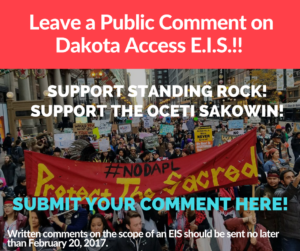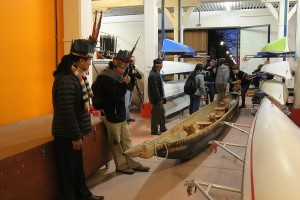President Trump is trying to circumvent the law and force the Dakota Access pipeline to get approved. But the Obama administration already started an Environmental Impact Statement (EIS) process and that can’t be disregarded.
The Army Corps of Engineers has to complete the EIS process before they can make any ruling on the final easement for the project to cross the Missouri River/Lake Oahe. And in order to complete the EIS, they have to take public comments.
So this is where you can help. The Indigenous Environmental Network has created an online process where you can submit your comment online and it will be directly emailed to the appropriate person.
But you don’t know what to say?
Well below is a blog article by engineering expert Steve Martin, who gives us 25 issues with the DAPL project! Check it out and when you are ready, click on this photo to leave your comment:
| [Steve Martin is a citizen of the Turtle Mountain Band of Chippewa Indians of North Dakota. He is currently the Chief Executive Officer and Director of KS Energy, a power generation and asset management company with principal offices in Gabarone, Botswana. In his capacity as an engineering expert Steve, along with a team of professionals, evaluated the technical aspects of the proposed Dakota Access Pipeline from an engineering perspective, and evaluated alternatives to the placement of the DAPL pipeline at its currently proposed location on behalf of the Cheyenne River Sioux Tribe.] |
By Steve Martin
Many of you have begun your work to identify sources to develop your opinions and comments on the EIS launched by the Army Corps of Engineers on January 18th. I asked Cheyenne River Sioux Tribe permission to share an outline of issues discussed in our engineering report to assist in forming opinions and comments. I received permission to share this with you late last night. Here, you can read the FULL REPORT and the COVER LETTER.
In general, while more elaborate in nature, our findings are very much in compliance with the indicated findings of the US Army Corps of Engineers “USACE” memo dated December 4, 2016 also referenced in the Presidential Memo on DAPL.
This article does not address the Indian Treaty or other non-technical issues. I’ve left those to others more capable of addressing.
I would encourage you to write your own letter. Pick a topic or two that you truly feel makes you passionate and that had the most impact on you personally and make your arguments heard. Click here to Submit your Comment now!
For now, I’m happy to present you with the attached table that summarizes the main issues of the DAPL EA from our report for your consideration.
Download the pdf of the Top 25 Issues with the Dakota Access pipeline here!
Below is the list of the 25 Issues with DAPL:
Issue No: |
DAPL Environmental Assesment Explanation of Issues |
1 |
The finding of no significant impact (FONSI) for the crossing of Lake Oahe in a HDD tunnel 92’ below the surface of the lake is a wrong conclusion presented by the DAPL EA and initially supported by USACE. |
2 |
The DAPL EA EA was prepared with a pre-decisional intent and is a biased document that appears to have been prepared with the desired result known from the outset. |
3 |
The DAPL EA lacks engineering integrity. The FONSI can neither be supported by previous precedent nor generally accepted industry practice and should be vacated immediately. |
4 |
Not enough reasonable alternatives were seriously considered by DAPL to address the unresolved conflicts between stakeholders. In particular, routing alternatives. |
5 |
The DAPL solution is the perfect technical storm and relies on the worst of all potential technical factors, including: (1) crude oil product (2) in a large-diameter pipeline and (3) in a 1.5 mile long HDD tunnel 92 feet below the surface of the lake. |
6 |
So much emphasis was placed on following the existing Northern Border gas pipeline routing completed in 1983 that an alternative route further north that would have resulted in no major or minor river or lake crossings was not even contemplated. |
7 |
It is inappropriate to authorize DAPL to cross Lake Oahe as contemplated in the EA without further analysis, more rigorous exploration and analysis of siting alternatives. Accordingly, the USACE did not grant easement to cross Lake Oahe as contemplated based on the current record. |
8 |
Preparing a full Environmental Impact Statement is the best and most responsible recommendation at this stage given the level of conflict between stakeholders and fatal flaws thus far discovered resulting in an inadequate EA. |
9 |
the USACE have clearly sided with the obvious need for the tribal government leaders and representatives or experts to be granted the ability to review and respond to the critical documents that had been previously kept secret from the tribe. These documents are• Lake Oahe Spill Model Discussion Report• Lake Oahe HDD Risk Analysis Report• DAPL Route Comparison. |
10 |
It is disappointing and troubling that these documents have still not been made available by DAPL to the tribes team of technical experts. |
11 |
The DAPL solution is the perfect technical storm and relies on the worst of all potential technical factors, including: (1) crude oil product (2) in a large-diameter pipeline and (3) in a 1.5 mile long HDD tunnel 92 feet below the surface of the lake. |
12 |
Without access to do a full technical review to evaluate further technical difficulties and based on what what was presented in the DAPL EA, there is no foundation that this is the least risk alternative or the finding of no significant environmental impact. |
13 |
The business interests of DAPL have compromised the integrity and responsibility of the engineers responsible for the DAPL project. |
14 |
The selection of the route was not based on the route posing the least risk alternative and that alone should be reason to support the need for a full review as contemplated by the USACE memo of December 4th. |
15 |
It has become well known that DAPL has negotiated commercial off-take agreements that required the pipelines commercial operation by January 1, 2017. It should be investigated further as to whether the routing recommended was premature and may have been the fallout of DAPL’s management desire to shorten the time to full commercial operation. |
16 |
The decision to recommend the routing under Lake Oahe appears to be the direct result of the heavy weighting DAPL applied to the requirement to follow the existing corridor in the questionable and subjective evaluation tables 2.1 and 2.2 in the EA. This was by far the dominating factor in the outcome of their analysis. Alternative objective routes should be evaluated. |
17 |
The results of the EA and the FONSI allowed USACE to prematurely issue the highly contested Section 408 permit. Unfortunately, the result led to the requirement to place the crossing at Lake Oahe. |
18 |
What the EA failed to evaluate or even present was another alternative route even further North and East of the Missouri River that should have been evaluated. This alternative routing has no major or minor river or lake crossings and is actually shorter than the current DAPL proposed routing. |
19 |
The key factor we would like to emphasize that the EA fails to discuss objectively is the fact that no similar application of a crude oil large diameter pipeline exists that crosses a freshwater lake via a large-diameter HDD tunnel anywhere in the World. |
20 |
The DAPL solution is the perfect technical storm and relies on the worst of all potential technical factors, including: (1) crude oil product (2) in a large-diameter pipeline and (3) in a 1.5 mile long HDD tunnel 92 feet below the surface of the lake. |
21 |
This design solution culminates in such an extreme high level of potential environmental and safety risk that an EIS is required because The EA does not currently address a leak or spill in the HDD section and full remediation of a clean-up of contaminated soil around the tunnel. Actually, clean-up of a spill in the HDD tunnel outside the pipe is a technical impossibility to perform. |
22 |
Unfortunately, the worst in this case means that any leak or spill in the HDD section results in permanent and deep contamination to the surrounding soils 92’ below the surface of the lake. Those contaminated soils will inevitably seep and poison the Hell Creek and Fox Hills aquifers and waters of Lake Oahe. The Hell Creek and Fox Hills formations are the major aquifers in the state and many residents depend on these formations for the water usage. These are regional aquifers for not only North Dakota but also other surrounding states. |
23 |
It appears placement of the HDD tunnel could not be any lower than the 92’ section because it would have run into the Pierre Formation, a dark grey to black shale that has low strength and has the high risk potential for causing landslides. Concerns about landslides have been presented by various local stakeholders as a significant project risk, including the Accufacts report prepared on behalf of the Standing Rock tribe dated October 28, 2016. The EA seems to support that this risk does not exist and we don’t have enough information to credibly confirm or deny this at this time. |
24 |
It is a proven fact that significant pipeline leaks and spills do occur regularly cannot be credibly denied. Project sponsors involved with this project thus far have completely ignored that the HDD crossing at Lake Oahe would become one of the rare examples of a perfect pipeline that never leaks or ruptures if it were to avoid soil and water contamination. |
25 |
NEPA requires the best currently available technical data be used in impact assessment. There is no way to mitigate a leak or rupture from contaminating the soil and water if a leak should happen in the HDD tunnel 92’ below the surface of the Lake. |
This is a follow up to the article I wrote on December 1, 2016 that helped me explain why I was so opposed to the proposed DAPL technical solution of burying the pipeline in a horizontal HDD tunnel 92 feet below Lake Oahe. That was one of the first articles on this project that really highlighted why this is such a bad idea and put me in touch with many of you new friends on Facebook and also with both the Standing Rock and Cheyenne River Sioux Tribes. Many of you encouraged me to get more involved with the tribes and I’m very pleased to report back that I have. I’ve been working with both tribes very close over the past couple of months and would like to ensure you all that there are some incredible people on the EIS teams of both tribes and we are working tirelessly to make sure that our leaders are educated and that the decision makers in Washington DC have the best perspective of facts in their hands to assist them in this process.
One of the tasks we were given by the Cheyenne River Sioux Tribe was to write a very detailed and objective engineering report to analyze the problems we see with the DAPL project, environmental assessment ‘EA’ and specifically the portion that would go in the HDD tunnel under Lake Oahe. An overwhelming focus has been on the HDD tunnel because this is the most obvious fatal flaw in our view. In reality, points of failure anywhere along the pipeline could cause any number environmental problems but the one thing that really sets this pipeline project apart from all the others is their intention to move crude oil in a large diameter pipe (30” dia) via a long HDD tunnel (~1.5m) under a fresh water reservoir lake (Lake Oahe).




